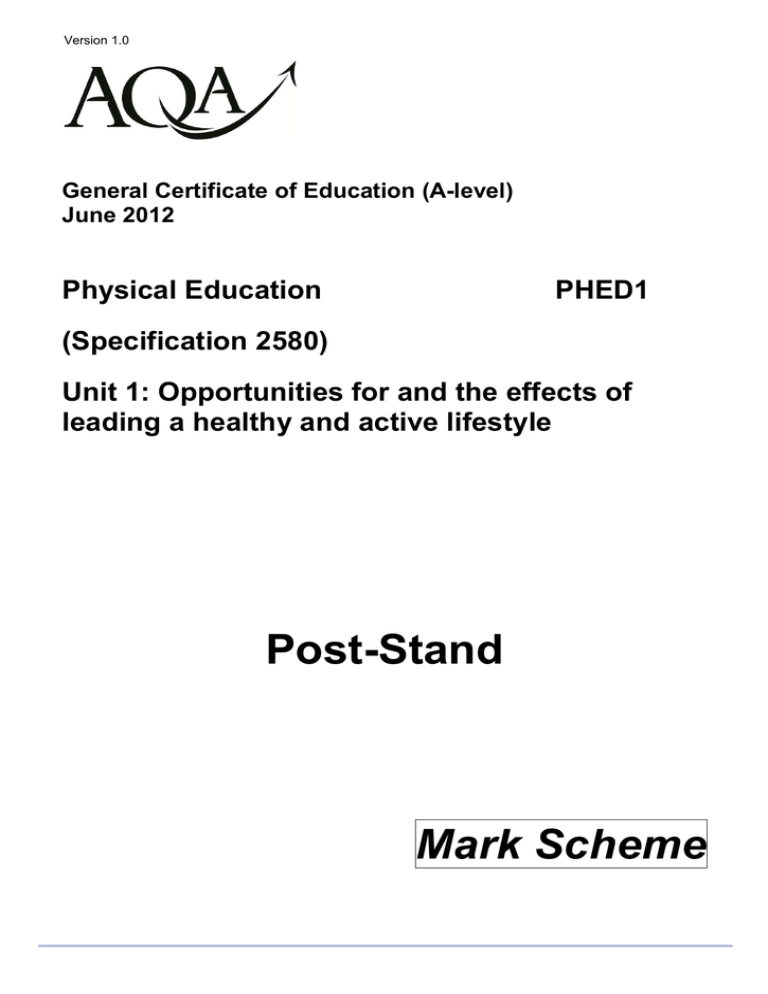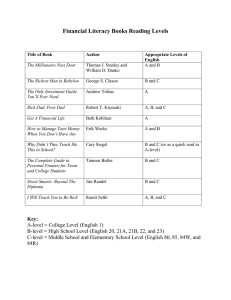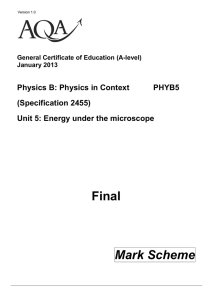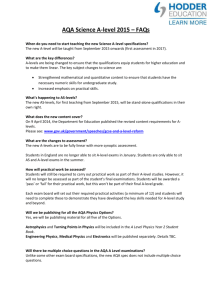
Version 1.0
General Certificate of Education (A-level)
June 2012
Physical Education
PHED1
(Specification 2580)
Unit 1: Opportunities for and the effects of
leading a healthy and active lifestyle
Post-Stand
Mark Scheme
Mark schemes are prepared by the Principal Examiner and considered, together with the
relevant questions, by a panel of subject teachers. This mark scheme includes any
amendments made at the standardisation events which all examiners participate in and is the
scheme which was used by them in this examination. The standardisation process ensures
that the mark scheme covers the students’ responses to questions and that every examiner
understands and applies it in the same correct way. As preparation for standardisation each
examiner analyses a number of students’ scripts: alternative answers not already covered by
the mark scheme are discussed and legislated for. If, after the standardisation process,
examiners encounter unusual answers which have not been raised they are required to refer
these to the Principal Examiner.
It must be stressed that a mark scheme is a working document, in many cases further
developed and expanded on the basis of students’ reactions to a particular paper.
Assumptions about future mark schemes on the basis of one year’s document should be
avoided; whilst the guiding principles of assessment remain constant, details will change,
depending on the content of a particular examination paper.
Further copies of this Mark Scheme are available from: aqa.org.uk
Copyright © 2012 AQA and its licensors. All rights reserved.
Copyright
AQA retains the copyright on all its publications. However, registered schools/colleges for AQA are permitted to copy material
from this booklet for their own internal use, with the following important exception: AQA cannot give permission to
schools/colleges to photocopy any material that is acknowledged to a third party even for internal use within the centre.
Set and published by the Assessment and Qualifications Alliance.
The Assessment and Qualifications Alliance (AQA) is a company limited by guarantee registered in England and Wales (company number 3644723) and a registered
charity (registered charity number 1073334).
Registered address: AQA, Devas Street, Manchester M15 6EX.
Mark Scheme – General Certificate of Education (A-level) Physical Education – PHED1 – June 2012
Section A
Question
Answer
1 (a) (i)
A. Fitness – cope/meet everyday
demands of the environment and
health – complete social, mental and
physical well-being
A. Can be unhealthy/get cold/flu/injury/
and unable to train/fitness declines
B. Can be unhealthy but able to train
and fitness can still improve
1 (a) (ii)
1 (b)
Movement
description
Shoulder
A-C
Elbow B-D
1 (c)
1 (d)
Marks
Main
Joint action
agonist
A. Pectorals B. Horizontal
/(anterior)
flexion/
Deltoids
horizontal
adduction
C. Biceps
D. Flexion
(brachii)
A. Detected by chemoreceptors (in
carotid arteries/aortic arch/medulla)
B. Nerve impulses/message to
respiratory control centre in/medulla
of brain
C. Nervous output to breathing
muscles/via Phrenic/ sympathetic
nerve
D. Increased rate of contraction of
diaphragm and intercostal muscles
A. Alveolar/muscle and capillary
membranes identified
B. Requires thin membranes/one cell
thick
C. Requires short distance between
membranes/moist/(semi) permeable/
short diffusion pathway
3
Commentary
1
Both phrases required 2/3 terms
for health
2
Need to link decreased fitness
because of ill-health
Need to link increased fitness
despite ill-health
A. Either term – Accept pectoralis
major – NOT pecs or delts
B. Not just flexion – Accept
horizontal hyper-extension to
flexion
C. Accept bicepts
D. Accept extension to flexion
4
3
A. Equiv of detected required
B. Equiv of messages/
information required – Do NOT
accept RCC
C. Equiv of connection to
breathing muscles – Do NOT
accept SNS
D. Increased/equiv required
2
Sub max 1 mark
B. Eq of thin required
C. Eq of short required
Mark Scheme – General Certificate of Education (A-level) Physical Education – PHED1 – June 2012
2 (a) (i)
2 (a) (ii)
2 (b) (i)
2 (b) (ii)
2 (c) (i)
A. Agility/balance/co-ordination/reaction
time
A. Strength/power/speed/flexibility
A. C
A. (Thick) Elastic walls
B. (Small) lumen
C. (Smooth) muscle layer
D. Carrying blood away from the heart/
to tissues/muscles
E. Cushion and smooth out/recoil/pulse/
withstand pumping action/pressure/
velocity from heart
1
First two answers only
1
1
3
First two answers only
Accept first answer only
Required terms for A, B and C
A. In muscle
B. Stores/supplies/carries oxygen
2
D. ‘Carry oxygenated blood’ is
incorrect because not
completely true, but ‘carry
oxygenated blood away’ is
correct because direction
given
Required term is muscle
2 (c) (ii)
4
A. Increase in (blood/body) temperature
B. Increase in blood carbon dioxide
concentration (pCO2)
C. Increase in blood acidity/increase in
hydrogen ions/decrease in pH
D. Bohr shift
E. Resulting in less saturation/reduced
affinity of haemoglobin with oxygen
F. An increase in oxygen release/
oxyhaemoglobin dissociation to
muscles/muscles receive more O2
4
Sub max 3 marks
A. Increase/eq required
B. Increase/eq required
C. Increase/eq required
D. Required term
Sub max 2 marks
Mark Scheme – General Certificate of Education (A-level) Physical Education – PHED1 – June 2012
3 (a)
3 (b)
3 (c) (i)
3 (c) (ii)
3 (c) (iii)
A. Receives information/feedback from
senses/Short Term Sensory Store
B. Selective attention filters information
C. Compares/identifies characteristics of
information to/from Long Term
Memory stores/DCR process
D. Decisions made/thinking/problemsolving/working memory
E. Receives information/motor
programme/sub-routines concerning
actions from Long Term Memory
F. Initiates/runs motor programme/subroutines sends to effector
A. Open skill – involves different/
changing environment/need to make
decisions about how to adapt skill/eg
open play situation/passing
B. Closed skill – involves same
environment/few decisions about how
to perform skill, just when to perform/
eg dead ball situation/set piece
A. Movement time – the time taken from
the initiation/start of the movement/
pass to finish/completion of
movement/pass
B. Reaction time – the time taken to
decide a response/type of pass to a
given stimulus/time taken from the
onset of the stimulus to the start of
the movement/pass/response
A. Choice Reaction Time – numerous
stimuli and/or responses and Simple
Reaction Time – one stimulus and
one possible response
B. Games – open skills need CRT
mainly/predominate/many choices/
decisions/few SRT skills/moments
A. Concentration/pay attention/selective
attention/focus on cues
B. Relevant practice/overlearning
C. Be at optimum arousal level/
increased arousal/alertness
D. (Temporal/spatial) anticipation/predict
actions/trying to identify cues earlier
E. Mental rehearsal
F. Improve movement time/improve
fitness/improve reaction time
G. Intensity of stimulus/a warning signal
5
3
Accept abbreviations
Accept correct annotated
diagrams
B. Selective attention/eq is a
required term
C. Idea of perception by
comparison to LTM
E. Idea of LTM as store of
movements that go into STM
2
A. Must be from a team game
Must have correct example of
skill for mark
B. Must have correct example of
skill for mark
2
A. Can be answered either from
definition of movement time or
what’s involved in game
B. Can be answered either from
definition of reaction time or
what’s involved in game
2
A. Require explanation
of/difference between both
between terms for mark
B. Idea that games skills require
decision/choice of actions
3
B. Not just practice – needs
contextualising – relevant/
specific
E. Accept imagery/visualisation
Mark Scheme – General Certificate of Education (A-level) Physical Education – PHED1 – June 2012
4 (a)
4 (b)
4 (c) (i)
A. Consistent/repeatable success/very
few mistakes/maximum certainty
B. Efficiency/minimisation of time
C. Coordination/controlled/fluent/flowing/
smooth
D. Adaptable
E. Minimal outlay of energy/appears
effortless
F. Aesthetically pleasing
G. Goal oriented behaviour/
predetermined/intention matches
outcome/precise/accurate/correct
A. Skills learnt in one activity affects/
influence/impact/eq in another
B. Positive – enhances/helps/aids the
learning of a new skill/egs
C. Negative – hinders learning of new
skill
D. Zero – has no effect on learning of
new skill
E. Retroactive – current practice
enhances learning of previously
learned skill
F. Proactive – current practice
enhances learning of skill yet to be
learned
G. Bilateral – practise on limb on one
side of body improves other side
A. Schema – set of ‘rules’/relationships
to help us make decisions about
movement patterns
B. Following/during movement/action
C. Sensory consequences
D. eg feedback information concerning
performance/Knowledge of
performance/kinesthesis/intrinsic
feedback/how it felt
E. Response/movement outcome
F. Comparison of actual and intended
outcome/feedback/knowledge of
results/what happened
6
3
3
Sub max 1 mark – require clear
definition of transfer which doesn’t
include an example of transfer
Accept ‘enhanced and worsens’
Any examples must be about
skills, NOT sports, and must be
explained
B. Not has positive affect
C. Not has positive affect
D. Not has zero affect
4
C. Required term
D. NOT KP
E. Required term
F. NOT KR
Mark Scheme – General Certificate of Education (A-level) Physical Education – PHED1 – June 2012
4 (c) (ii)
A. Vary practised conditions by
changing initial conditions/
appropriate example
B. Realistic/specific practice to activity
C. Build up set of response
specifications/movement
requirements/outcomes practised
D. eg weight of implement/flight of ball
E. Frequent/lots feedback
F. Teach fundamental/simple skills
before sport specific skills
7
2
Mark Scheme – General Certificate of Education (A-level) Physical Education – PHED1 – June 2012
5 (a)
5 (b) (i)
Similarities
4
A.
B.
C.
D.
E.
F.
G.
Both voluntary/choice/free will
Both social/friendship groups
Both develop skills/suitable egs
Both develop health/fitness
Both can be creative/expressive
Both self-officiating/few pre-set rules
Both informal learning/not taught/
assessed
H. Both non-serious end product/
intrinsic rewards/fun
A. NOT leisure time
B. NOT non-competitive
Differences (based on recreation)
I. Adults = recreation and children =
play
J. Recreation = time free from work and
children don’t work
K. Recreation organised/some pre-set/
modified rules/etc and play is
spontaneous/eq
L. Adults escape reality/stress relief/
Cathartic and children model/master
reality
Sub max 3 marks
Accept reverse
A. Business run by Local Authority/
Council
B. For local community use/anyone
C. Trading at set prices/pre-set budget/
no need for profit
D. Subsidised by tax/grants
E. Managed by LA employees/some
aspects run privately/PFI/PPI
F. Facilities not as good as private
sector
G. Can be ‘pay as you go’/not
necessarily subscription-based/
subsidised use/more affordable fees
than private facilities
8
F. NOT no rules
3
A. Key term is Local Authority/
Council – NOT government
C. NOT profit-loss basis
D. Accept government funding
Mark Scheme – General Certificate of Education (A-level) Physical Education – PHED1 – June 2012
5 (b) (ii)
5 (c)
A. Public sector forced to account more
for the use of local taxes
B. Consider best value for money/
improve efficiency of provision/
resources/funds/experiences they
offer
C. Use of private sector methods to
achieve/eg better facilities/more
classes
D. Find out what local people want and
expect/quality of life/community
choice/consult
E. Set standards and deliver services to
match those standards/compare
F. Measure success/compete
G. Review expectations/challenge
A. Advertising/publicity/role models
B. Reduced costs/entry fees/
equipment/hire fees
C. Taster/sampling sessions/fun days
D. More inner city facilities
E. Session run at suitable times/crèches
F. School extra-curricular sessions
9
2
3
Mark Scheme – General Certificate of Education (A-level) Physical Education – PHED1 – June 2012
6 (a) (i)
6 (a) (ii)
A. Played regularly/often/fixtures/
leagues/regionally/nationally-based
B. Written/complex rules/codification
C. Standards of behaviour/etiquette/
civilised/fair play/sportsmanship
D. Highly structured/set times/number of
players/boundaries/officials/kit/
equipment
E. Skill based/refined/complex/tactics
developed
F. Spectators as well as participants
A. Society becoming more civilised/
better mannered/less violent/Acts of
Parliament banned activities – mob
football
B. Upper/middle classes controlled
society/social control (of working
classes)
C. Industrialisation – need for disciplined
workforce/factory teams
D. Era of social reform/philanthropists
E. Role of church/Protestant work ethic/
church teams/boys clubs
F. Lack of space meant no room for
popular recreations/urbanisation
G. Administration needed as more
clubs/national governing bodies/
‘melting pot’
H. Transport and communication
developed
10
3
E. Not just rules!
D. Accept organised
3
Mark Scheme – General Certificate of Education (A-level) Physical Education – PHED1 – June 2012
6 (b)
A. Discrimination – to make distinction
and treat people unfairly
Yes – effective
B. Increased range of activities among
minorities
C. eg Asian Cricket, Afro-Caribbean
football, women’s rugby, Paralympics
D. More role models in UK sport
E. Campaigns/sport equity targets by
NGBs/Kick Racism Out
F. Use of the law by individuals/bans for
‘racist’ actions/’Suarez’/’Terry’ etc
G. Awareness education/effects of
discrimination for teachers/ coaches
in schools/youth clubs
H. Sports Development Officers
promote increased minority
participation
I. PE programmes cater for minority
preferences/Muslim women only
classes/eg relaxed kit/ showering
rules
J. Sport England/eq programmes/YST
programmes/Top Sportsability/
Sporting Equals promote equality
No – not effective
K. Minorities from lower socio-economic
groups/lack of time/money
L. Participants may be subject to racist/
sexist comments/abuse/stereotypical
expectations/discrimination
M. Membership by invitation/vetting may
exclude minorities
N. Sport has a lower social status within
certain communities cultural/religious
requirements may discourage sport
participation
O. Lack of administrators/coaches/role
models for minorities
11
6
Must indicate whether effective or
not
Sub max 4 marks
Solutions to discrimination
suggests not effective – points K
to O
Sub max 4 marks
Mark Scheme – General Certificate of Education (A-level) Physical Education – PHED1 – June 2012
Section B
7
A. Active – stretched position held by
performer’s own agonist
B. Passive – stretched position held by
another body part/or position held by
partner
C. Static/PNF – stretched position held
and isometric contraction applied
D. Ballistic – bounce in and out of
stretch
E. Dynamic – stretch through specific
sports movement
F. Warm-up prior to stretching/begin
slowly/stretching as part of a cooldown
G. Make stretch sports specific
H. Hold/repeat stretch for (30) seconds
I. Never hold a painful stretch/danger of
injury – no ballistic
J. Balance/equalise stretches/agonists
and antagonists
K. Perform whole skill to gain feel/
appreciate flow/sequence/kinesthesis
L. Depends on nature/type of skill –
Complex or simple
M. Use whole if skill complex/hard to
break down/high
organisation/discrete/simple – no
need to break down
N. Depends on stage of learning/
beginner/novice/experience
O. Use whole if autonomous/cognitive
stage
P. Depends on safety/time
Q. Only use whole if safe to do so/no
chance of injury/short of time
R. Depends of fitness
S. Use whole if performer fit enough to
manage repeating skill
T. Depends on motivation
U. Use whole if highly motivated
because success not certain
12
12
A. Named and described
B. Named and described
C. Named and described
D. Named and described
E. Named and described
G. Idea of stretch being specific
for activity being performed
H. Agonist and antagonist
Credit explanation of why use of
whole
Stated factor
Explanation of factor
Explanation of factor
Required term
Safety concerned
Explanation of factor
Stated factor
Explanation of factor – needs
because
Accept reverse – not whole if unfit
Accept reverse – not whole if not
motivated
Mark Scheme – General Certificate of Education (A-level) Physical Education – PHED1 – June 2012
Mark Scheme
Band
Range
10 – 12
Band descriptors
7–9
4–6
1–3
Addresses all aspects of question, demonstrating wide range of depth and
knowledge
Expresses arguments clearly and concisely
Good use of examples to support answer
Few errors in their spelling, punctuation and grammar, and correct use of
technical language
Addresses most aspects of question, demonstrating clear level of depth and
knowledge
Attempts to express arguments clearly and concisely
Uses examples to support answer
Few errors in their spelling, punctuation and grammar, and correct use of
technical language, although sometimes inaccurately
Addresses some aspects of question, but lacks sufficient depth and knowledge
Limited attempt to develop any arguments or discussions, normally vague or
irrelevant
Attempts to use examples although not always relevant
Errors in spelling, punctuation and grammar, and limited use of technical
language
Addresses question with limited success
Little or no use of examples
Major errors in their spelling, punctuation and grammar, and little use of technical
language
Number of
correct
responses
Level
achieved
Discriminator
Initial
mark
Optional
QWC/
coverage
Potential final
mark
13+
4
15+ items
11
+1
11 or 12
13 or 14 items
10
+1
10 or 11
11 or 12 items
8
+1
8 or 9
9 or 10 items
7
+1
7 or 8
7 or 8 items
5
+1
5 or 6
5 or 6 items
4
+1
4 or 5
3 or 4 items
2
+1
2 or 3
1 or 2 items
1
+1
1 or 2
9-12
5-8
1-4
3
2
1
0
0
13



